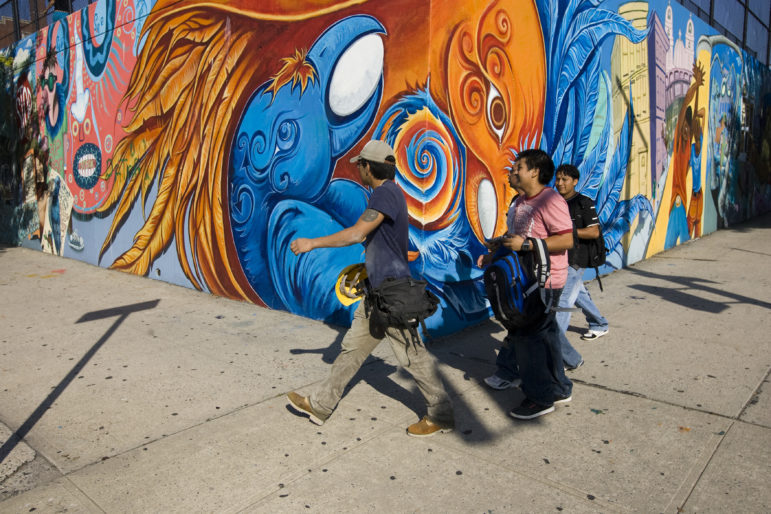
J. Silberberg
People walk passed a mural near a high school in Bushwick, 2009.
This is the introduction to City Limits’ 2009 magazine issue on Bushwick.
In the nearly eight years since Michael Bloomberg was elected mayor, 870,000 babies have been born in New York City, and 400,000 people have died. More than 5.8 billion car trips have been made into and out of the city. Forty thousand new buildings have been started. The fire department has battled more than a quarter million blazes and people have reported 180,000 robberies to the police. John F. Kennedy International Airport has seen 2 million takeoffs and landings. The Yankees and Mets have played almost 2,600 times, while Staten Island ferries have logged enough nautical miles to go to the moon and back three times. On 19,000 occasions, St. Patrick’s Cathedral has celebrated Mass. Ten billion shares changed hands at the stock exchange.
When New Yorkers head to the polls in November, they will decide whether the mayor will spend another four years in office. Whatever the outcome when the votes are counted, an election is a time to size up how the city has changed—is it better, worse or just plain different?—during the Bloomberg era.
New Yorkers live in a metropolis, but they dwell in a neighborhood, probably in a section of city consisting of a few blocks. It’s there that they live, shop, catch the subway to work and bring the kids to school, and it’s where the city’s successes and failures are most keenly felt.
One such area is ZIP code 11237 in Brooklyn. One of New York’s 300-odd ZIP codes, 11237 has the distinction of containing, according to the Department of City Planning, the geographic center of the city of New York, on the block of Stockholm Street between Wyckoff and St. Nicholas avenues. When the federal government last counted in 2000, there were 48,642 people living in the ZIP, which comprises the northern half of the neighborhood of Bushwick.
A lot has changed in 11237 during Bloomberg’s time as mayor. Reported crime is lower and the schools are posting better scores. Thousands of manufacturing jobs have vanished and housing has become harder to afford. Most of the changes have roots that go years deep, and some are the product of forces well beyond any mayor’s control. But city policy has played a role in all of it. Over the past eight years, there has been real progress against old problems in Bushwick, and new problems have emerged.
This is a look at some of what has happened in one ZIP code since 2001. What follows might not encompass the full story of the wider city. But it is part of that larger tale.
Get the best of City Limits news in your inbox.
Select any of our free weekly newsletters and stay informed on the latest policy-focused, independent news.








